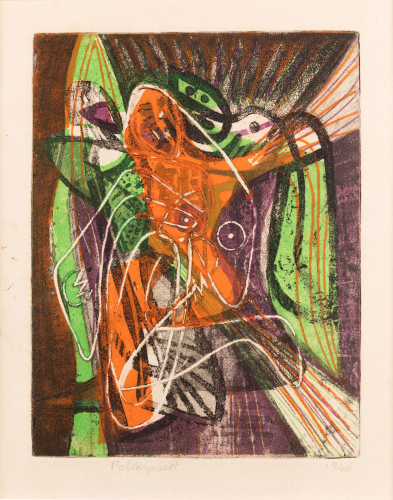
Interested in Selling?
Request a valuation
Interested in Selling?
Request a valuation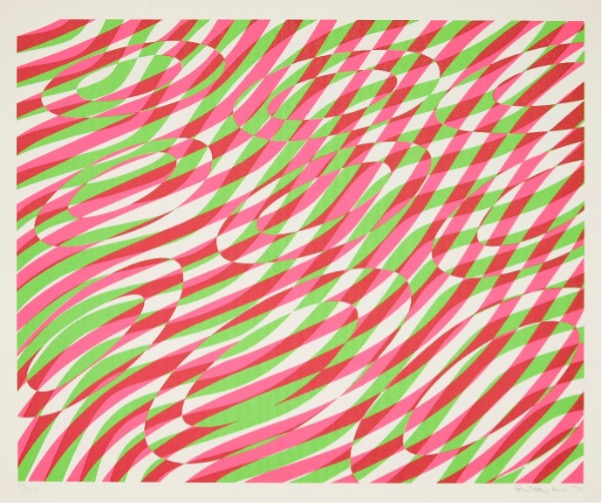
Stanley William Hayter CBE, British 1901-1988- Allegro [Black & Moorhead 336], 1970; screenprint in colours on BFK Rives wove for sale in the upcoming Prints & Multiples auction : 7 July 2020
Stanley William Hayter CBE is widely regarded as one of the most significant printmakers of the 20th century. Known for his surreal and abstract expressionism, Hayter pioneered new forms of intaglio printing, never settling on a particular technique throughout his lifetime. Though he is celebrated by print makers and historians, he has often been neglected in British art history, here we introduce and explore the artist’s history as a legendary print-maker.
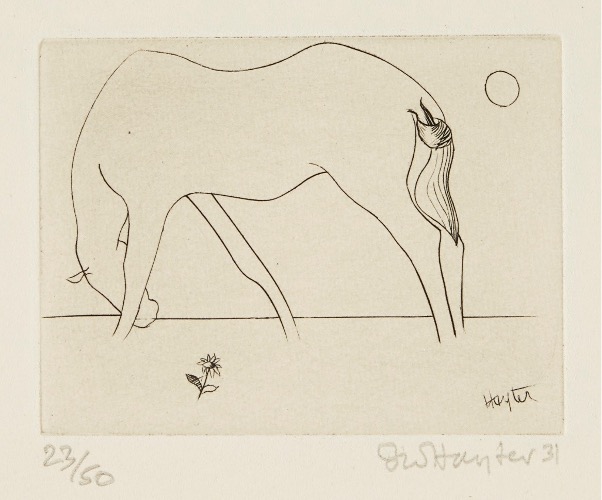
Stanley William Hayter CBE, British 1901-1988- Small Horse [Black & Moorhead 45], 1931; engraving on wove for sale in the upcoming Prints & Multiples auction : 7 July 2020
Hayter, born in 1901, was the son of a British painter, and it seems as though creativity ran in the family. Though he studied Chemistry at King’s College, London, by 1926 he had moved to Paris to study at the Academie Julian. In his first year Hayter was introduced to copper engraving, and went on to acquire his own printing press and opened a printmaking studio, Atelier 17, in 1927.
Hayter was driven in his improvement and exploration of the intaglio print-making methods; engraving, etching, aquatint and soft ground. He was a scholar of the craft, and saw collaboration as a means to both develop his own skills and spread the gospel of printmaking.
Hayter’s charismatic personality and drive to develop printmaking, attracted students, collaborators and independent artist alike. Atelier 17 became a hub for mentorship where young artists could work alongside experienced printmakers such as Pablo Picasso, Jankel Adler and Massimo Campigli. In the early 1930s Hayter collaborated on editions with some of the world’s most famed artist including Joan Miró and Kandisnky.
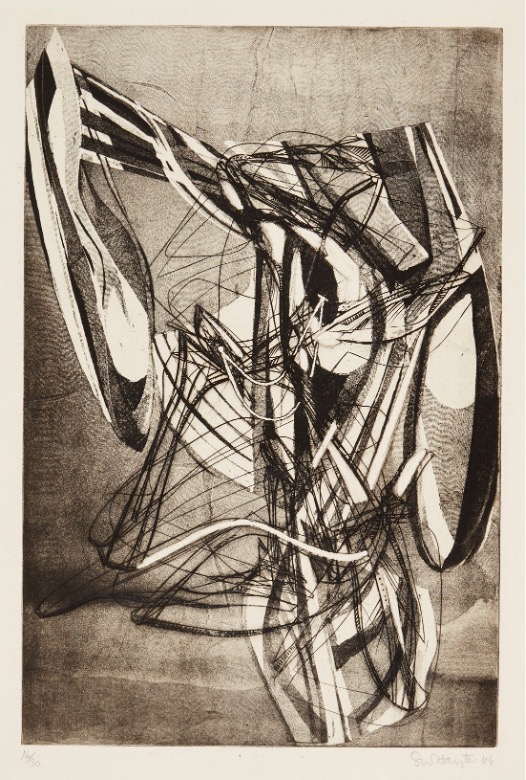
Stanley William Hayter CBE, British 1901-1988- Flight [Black & Moorhead 159], 1944; engraving with soft-ground etching and scorper on Kochi wove for sale in the upcoming Prints & Multiples auction: 7 July 2020
In an observation of his early work we can see a transition into surrealism through his study of form and structure. Hayter opposed the use of preparatory drawings reflecting his sense of improvisation and fluidity. His expressive lines were an ideal base with which to experiment with technique. Hayter often opted to use neglected materials or techniques, as these had more potential for innovation. He favoured soft-ground over aquatint, and experiment with textures using lace, wood and bark to lift the ground from the plate. These experimentations helped to develop the reputation of Atelier 17, with many of Hayter’s original experimental techniques, such as those with soft-ground, going on to be widely adopted and taught in art schools across the globe.
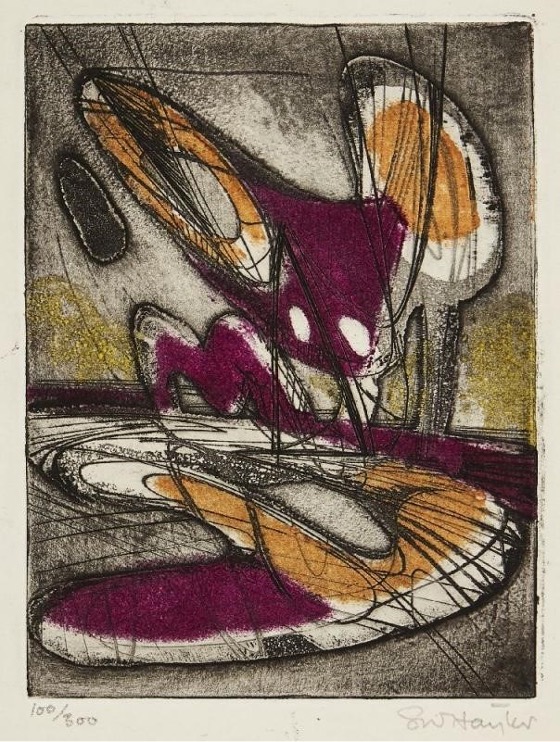
Stanley William Hayter CBE, British 1901-1988- Night Moth (Laurels Number One) [Black & Moorhead 171], 1946; aquatint with engraving, soft-ground etching and scorper in colours on Kochi laid for sale in the upcoming Prints & Multiples auction : 7 July 2020
At the outbreak of World War II Hayter moved Atelier 17 from Paris to New York. Word of his gestural style and innovative practice had spread to the US and many young artists were drawn to the studio hoping to meet the founder. Emphasising the importance of process he began working with artists such as Rothko and Pollock, spending months and years assisting artists with the development of very technical skills.
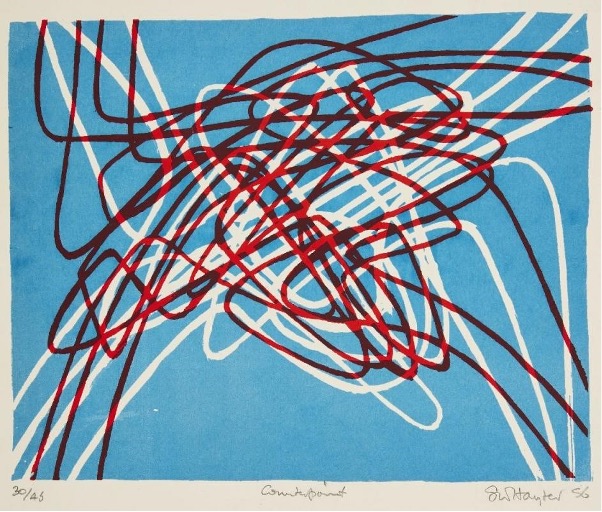 \
\
Stanley William Hayter CBE, British 1901-1988- Contrepoint [Black & Moorhead 229], 1956; screenprint in colours on Alfa wove for sale in the upcoming Prints & Multiples auction : 7 July 2020
Hayter’s early scientific studies aided his mastery of technical printmaking. Using a scientific knowledge of oils, acids, abrasives, metals and solvents Hayter used the plate as a base for precise experimentation. During his time in New York Hayter developed his ‘Simultaneous Colour Printing’ technique, where he used different ink viscosities to create layers of colour, applying the ink with rags, stencils or rolling to alter the depth and opacity.

Stanley William Hayter CBE, British 1901-1988- Piscine [Black & Moorhead 419], 1981; engraving in colours on BFK Rives wove
In 1950 Hayter once again returned to Paris, taking Atelier 17 back to its European origin. He was a prolific artist and continued to work until his death in 1988, producing around 460 prints. His innovative work made him a key figure in the education of print makers. Hayter never seemed to have his fill of experimentation and each technique he took on was explored rigorously until he felt he could move to the next. His abstract expressionism certainly paved the way artistically for many artists to come, however his contributions to the world of print making, including the many works produced directly at Atelier 17 have changed the face of print making and modern art as we know it.
If you would like to receive updates about work by the artist coming up in future sales, please register for an account to set up key-word alerts.
Stanley William Hayter CBE, British 1901-1988- The Aquar...
Price Realised: £1,170
Stanley William Hayter, British 1901-1988, Palimpsest, 1946; screenprint in...
Price Realised: £1,820
Stanley William Hayter CBE, British 1901-1988- Flight [B...
Price Realised: £975
Stanley William Hayter CBE, British 1901-1988- Danse Du ...
Price Realised: £845
Stanley William Hayter CBE, British 1901-1988- Le Couple...
Price Realised: £845
Stanley William Hayter CBE, British 1901-1988- Angels Wr...
Price Realised: £1,196
Stanley William Hayter CBE, British 1901-1988- Le Couple...
Price Realised: £845
Stanley William Hayter, British 1901-1988- Untitled dr...
Price Realised: £468
Stanley William Hayter CBE, British 1901-1988- Night Mot...
Price Realised: £650
Stanley William Hayter CBA, Biasi Bona, Marie Cerminova (Toyen) and ...
Price Realised: £715
Stanley William Hayter CBE, British 1901-1988- Rue de la...
Price Realised: £650
Stanley William Hayter CBE, British 1901-1988- Interfer...
Price Realised: £572
Stanley William Hayter CBE, British 1901-1988- Champ Magné...
Price Realised: £442
Stanley William Hayter CBE, British 1901-1988- Hex [Blac...
Price Realised: £390
Stanley William Hayter CBE, British 1901-1988; New Year&...
Price Realised: £845
Stanley William Hayter CBE, British 1901-1988- Icarus [B...
Price Realised: £1,105
Stanley William Hayter CBE, British 1901-1988- Night sea...
Price Realised: £520
Stanley William Hayter CBE, British 1901-1988- Floating ...
Price Realised: £546
Stanley William Hayter CBE, British 1901-1988- Saddle [B...
Price Realised: £715
Stanley William Hayter CBE, British 1901-1988- Scorpio [...
Price Realised: £598
Stanley William Hayter CBE, British 1901-1988- Masque [B...
Price Realised: £364
Stanley William Hayter CBE, British 1901-1988- Equinox [...
Price Realised: £468
Stanley William Hayter CBE, British 1901-1988- Rideau [B...
Price Realised: £338
Stanley William Hayter CBE, British 1901-1988- Nereide [...
Price Realised: £845
Stanley William Hayter CBE, British 1901-1988- Torso [Bl...
Price Realised: £312
Stanley William Hayter CBE, British 1901-1988- Contrepoi...
Price Realised: £520
Stanley William Hayter CBE, British 1901-1988- Swimmers [B...
Price Realised: £468
Stanley William Hayter CBE, British 1901-1988- Schilde...
Price Realised: £260
Stanley William Hayter CBE, British 1901-1988- Invocat...
Price Realised: £338
Stanley William Hayter CBE, British 1901-1988; España...
Price Realised: £338
Stanley William Hayter CBE, British 1901-1988- Fold [Bl...
Price Realised: £390
Stanley William Hayter CBE, British 1901-1988- Diptych...
Price Realised: £715
Stanley William Hayter CBE, British 1901-1988- II, IV a...
Price Realised: £572
Stanley William Hayter CBE, British 1901-1988- Sea Serp...
Price Realised: £546
Stanley William Hayter CBE, British 1901-1988- VI, VII...
Price Realised: £338
Stanley William Hayter CBE,British 1901-1988,Sea Serpent [Black & Moorhead ...
Price Realised: £442
Stanley William Hayter CBE,British 1901-1988, Poissons Volants, 1958; etc...
Price Realised: £468
Stanley William Hayter CBE, British 1901-1988, Warriors, 1953; colour engr...
Price Realised: £520
Stanley William Hayter CBE, British 1901-1988- Pillars [...
Price Realised: £520
Stanley William Hayter CBE, British 1901-1988- Helix [Bl...
Price Realised: £338
Stanley William Hayter CBE, British 1901-1988- Caragh La...
Price Realised: £598
Stanley William Hayter CBE, British 1901-1988- Clairvoie...
Price Realised: £338
Stanley William Hayter CBE, British 1901-1988- Dromond [...
Price Realised: £338
Stanley William Hayter CBE, British 1901-1988- Labris [B...
Price Realised: £624
Stanley William Hayter CBE, British 1901-1988- Champ Ora...
Price Realised: £520
Stanley William Hayter CBE, British 1901-1988- Nenuphars...
Price Realised: £442
Stanley William Hayter CBE, British 1901-1988- Shoal Gre...
Price Realised: £520
Stanley William Hayter CBE, British 1901-1988- Piscine [...
Price Realised: £1,170
Stanley William Hayter CBE, British 1901-1988- "Lake"; soft ground e...
Price Realised: £325
Stanley William Hayter CBE, British 1901-1988- Untitled; screenprint...
Price Realised: £260
Stanley William Hayter CBE, British 1901-1988- "Slip Stream"; screen...
Price Realised: £260
Stanley William Hayter CBE, British 1901-1988- Horizon ...
Price Realised: £338
Stanley William Hayter CBE, British 1901-1988- Allegro...
Price Realised: £520
Stanley William Hayter CBE, British 1901-1988- Wake [Bla...
Price Realised: £390
Stanley William Hayter CBE, British 1901-1988- Outward [...
Price Realised: £234
Stanley William Hayter CBE, British 1901-1988- Small Hor...
Price Realised: £468
Stanley William Hayter CBE, British 1901-1988- Gemini [B...
Price Realised: £286
Stanley William Hayter CBE, British 1901-1988- Araignee ...
Price Realised: £390
Stanley William Hayter CBE, British 1901-1988- Flowing T...
Price Realised: £247
Stanley William Hayter CBE, British 1901-1988- Convex Mi...
Price Realised: £780
Stanley William Hayter CBE, British 1901-1988- Allegro [...
Price Realised: £364
Stanley William Hayter CBE, British 1901-1988- Wind [Bla...
Price Realised: £468
Stanley William Hayter CBE, British 1901-1988- Calculus ...
Price Realised: £364
Stanley William Hayter CBE,British 1901-1988, Small Horse [Black & Moorhea...
Price Realised: £338
Stanley William Hayter CBE, British 1901-1988- "Clairevoie"; aquatin...
Price Realised: £442
Stanley William Hayter CBE, British 1901-1988- "Swimmer...
Price Realised: £299
Stanley William Hayter CBE, British 1901-1988- Sargass...
Price Realised: £286
Stanley William Hayter CBE, British 1901-1988- Emerald...
Price Realised: £572
Stanley William Hayter CBE, British 1901-1988- Apparitio...
Price Realised: £286
Stanley William Hayter CBE, British 1901-1988- Sagittari...
Price Realised: £572
Stanley William Hayter CBE, British 1901-1988- Parkinson...
Price Realised: £338
Stanley William Hayter CBE, British 1901-1988- Il Coment...
Price Realised: £468
Stanley William Hayter CBE, British 1901-1988- Wind [Bla...
Price Realised: £390
Stanley William Hayter CBE, British 1901-1988- Cover i...
Price Realised: £299
Stanley William Hayter CBE, British 1901-1988- Volet, ...
Price Realised: £468
Stanley William Hayter CBE, British 1901-1988- Cover illustration to...
Price Realised: £104
Stanley William Hayter CBE, British 1901-1988- Cover illustr...
Price Realised: £117
Stanley William Hayter CBE, British 1901-1988- untitled, 1979; etchi...
Price Realised: £124
Stanley William Hayter CBE, British 1901-1988- Astyanax 1979; etchin...
Price Realised: £85
Stanley William Hayter CBE, British 1901-1988- Hill Fi...
Price Realised: £208
Stanley William Hayter CBE, British 1901-1988- About B...
Price Realised: £91
Stanley William Hayter CBE, British 1901-1988- "The Engravings of S ...
Price Realised: £104
Would you like to receive personalised keyword alerts when new catalogues go live. If so, please indicate these below
Set a password to save your keyword alerts
Passwords are a minimum of 7 characters and must include an upper case letter, a lower case letter, a number and a special character (e.g., !@#$%^&*).

Roseberys, 70/76 Knights Hill London
SE27 0JD, United Kingdom
Opening Hours Monday - Friday 9.30am - 5pm
© Copyright 2023 Roseberys All rights reserved
If you have a RoseberysLive account, your username is now your email address.
or
As a buyer you will be able to register for auctions, leave bids, bid live online, create a wishlist of your favourite lots, sign up for customised keyword email alerts, get preferred recommendations, and view and pay your invoices.
As a seller you will be able to easily set up your client account, view all your pre and post sale documents, and select your preferences.
Alternatively, if you just wish to receive personalised keyword alerts when new catalogues go live, add lots to your wishlist , and set newsletter preferences create a ‘lite’ account.

